GERMANY
Berlin

Berlin
Berlin
Berlin is the capital of Germany. It is a city full of history: it played an important role in the Second World War and the Cold War that followed. You can still find characteristics of this everywhere in Berlin. In addition to the rich history of Berlin, the city is also known for its boundless hip nightlife, the friendly Berliners and the good and attractively priced gastronomy.
Location
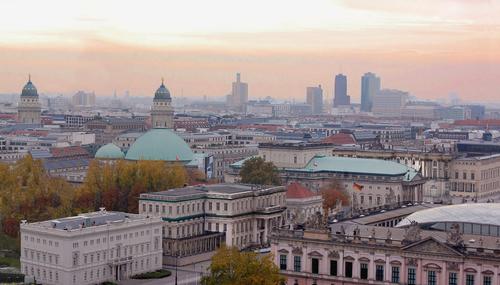 Berlin PanoramaPhoto: Bleppo in the public domain
Berlin PanoramaPhoto: Bleppo in the public domain
Berlin is the second largest city in the European Union. The city has about 3.4 million inhabitants. Berlin is located in the east of Germany, near the border with Poland. The city has an area of more than 891 km². The river Spree flows through Berlin, which flows into the river Havel towards the west of Berlin.
Berlin is known as one of the greenest cities in the world. No less than 19% of the city consists of forest and 6.7% of Berlin is water. Within Berlin there is even a large lake with the beautiful name the Großer Müggelsee. This lake has an area of 7.2 km².
Weather
Berlin has a mix of a maritime climate and a continental climate. This means that winters can be very cold and wet. Summers in Berlin, on the other hand, are warm and generally dry. Spring and autumn are usually mild in the German capital. Below you will find a number of average weather figures for Berlin.
Berlin Weather January: 2 °C
Berlin Weather February: 4 °C
Berlin Weather in March: 8 °C
Berlin Weather April: 13 °C
Berlin Weather in May: 19 °C
Berlin Weather June: 22 °C
Berlin Weather July: 23 °C
Berlin Weather August: 23 °C
Berlin Weather September: 19 °C
Berlin Weather October: 13 °C
Berlin Weather November: 7 °C
Berlin Weather December: 3 °C
History
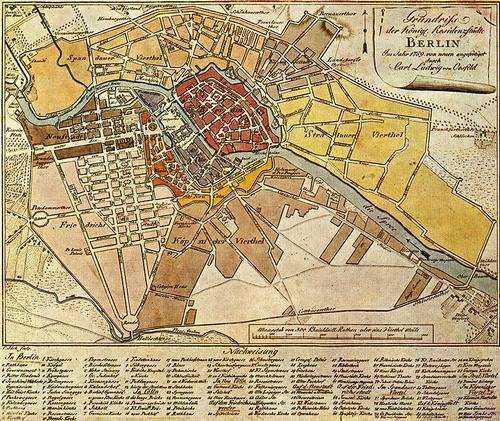 Berlin in 1789Photo:Public Domain
Berlin in 1789Photo:Public Domain
As mentioned earlier, Berlin has a rich history. Berlin was officially founded in 1237, but excavations reveal that the place was inhabited before. By the end of the 14th century, Berlin had about 8,500 inhabitants. In 1701, the city became the royal residence for Friedrich I, King of Prussia. In the course of the 18th century, the city became a center of enlightenment. Perhaps the most famous 18th century building is the Brandenburg Gate which was completed in 1791. In 1806 Berlin was occupied by Napoleon Bonaparte, but the city continued to grow after that. In 1871 Berlin became the capital of the German Empire and the city gained more and more status and economic growth.
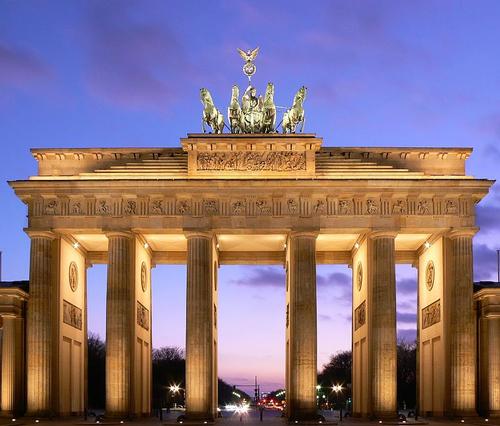 Berlin Brandenburger TorPhoto: Ger1axg CC 3.0 Unported no changes made
Berlin Brandenburger TorPhoto: Ger1axg CC 3.0 Unported no changes made
Especially in the 20th century a lot has happened in Berlin. After the First World War, Berlin became a republic. When the National Socialists gained more and more power in Germany, Berlin became the capital of the Third Reich in 1933. In 1936 the Olympic Games were organized in Berlin. This opportunity was seized with both hands by Hitler to make propaganda for his ideals.
Then followed the cruel history of World War II that we all know. On April 30 of 1945, Hitler, realizing that he was not going to win the war, committed suicide in a bunker in Berlin. A few days later, Germany surrendered.
After that, Berlin was taken by the Allies. These were France, Russia, England and the USA. At the Potsdam Conference, it was decided that Germany would be divided into four: a Russian, an American, a British and a French part.
Berlin was also divided into four as the capital. A dichotomy developed in Germany between the communist part of the Soviet Union and the capitalist parts of the other countries. This dichotomy was most apparent in Berlin. Berlin was divided into east and west. This also divided Germany into the German Democratic Republic (GDR) and the Federal Republic of Germany (FRG). The parts were separated from each other from 1961 by the world famous Berlin Wall. Only on November 9, 1989 the Wall fell and Berlin became one again. In some places in Berlin you can still see remains of the Berlin Wall.
Sights
A city with such a turbulent history as Berlin naturally has many sights. Below you can find some of the most beautiful, most impressive and most important sights.
Tiergarten is the park of no less than 210 hectares in Berlin. It is located right in the center and is truly an oasis of peace. In this beautiful park you can enjoy walking, cycling and picnicking. This park used to be the royal hunting ground, hence the name Tiergarten.
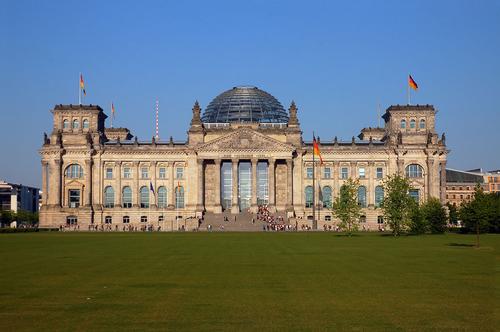 Berlin ReichstagPhoto:Public Domain
Berlin ReichstagPhoto:Public Domain
The Reichstag is the German parliament building. It is a beautiful building in which a modern architectural style is tastefully combined with the classical. The building's glass dome is the most eye-catching element. The dome can be climbed and from the top point you have a beautiful view of Berlin. The entrance is free and it is a unique experience. There are long lines in front of the Reichstag on most days, so you have to be patient.
An extensive and impressive memorial to the Holocaust can be found on Berlin's Eberstrasse. The monument was designed by the architect Peter Eisenman. He based the monument on the phrase: "It happened and therefore it can happen again." by the Italian writer and Auschwitz survivor Primo Levi.
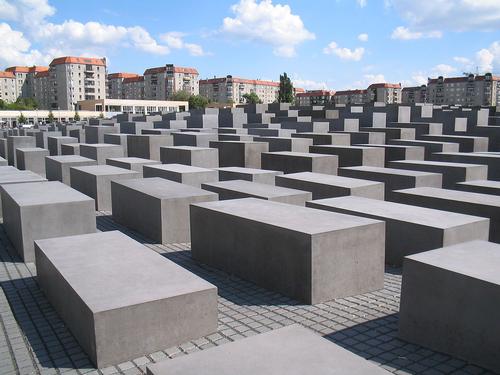 Berlin Monument HolocaustPhoto: K.Weisser CC 2.0 Germany no changes made
Berlin Monument HolocaustPhoto: K.Weisser CC 2.0 Germany no changes made
The monument consists of 2,711 blocks of concrete of different heights and the whole is almost three football fields in size. The different shadows created by the blocks give the monument a special and 'uncanny' atmosphere. An archive can be found under the Holocaust memorial in Berlin. If this attraction interests you, you may also want to visit the Jewish Museum of Berlin where many Jewish customs are explained and plenty of information about World War II is available.
Charlottenburg Palace is surrounded by beautiful gardens, which are well worth a visit. The gardens are open from sunrise to sunset. This beautifully restored palace was commissioned by the future Queen Sophie Charlotte over 300 years ago. In the early 19th century additional details and embellishments were added by Karl Friedrich Schinkel. In the palace there is a small collection of romantic paintings.
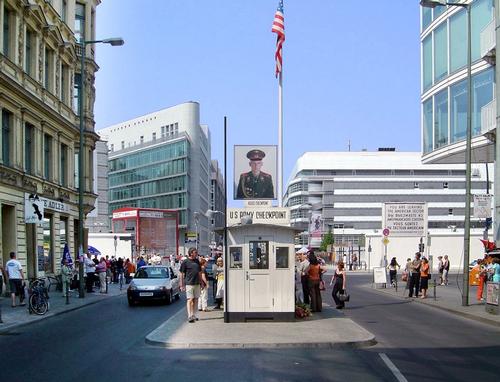 Checkpoint Charlie BerlinPhoto: Adrian Purser CC 2.0 Unported no changes made
Checkpoint Charlie BerlinPhoto: Adrian Purser CC 2.0 Unported no changes made
Checkpoint Charlie was the third Allied checkpoint tower and is named after the third letter of the military alphabet. After the border reopened in 1989, the tower was fitted with a crane and soon replaced by a replica guardhouse. In the area there is the famous text in English, Russian, French and German. "You are now leaving the American sector". Checkpoint Charlie is still considered one of the most famous parts of the Berlin Wall and has featured in many films. There is a watchtower and also a red line that clearly marks the former east-west dividing line.
In the Museum of Applied Art you will find a wide range of arts and crafts. The highlights are beautiful Art Deco ceramics, 16th century silver chalices, beautiful Venetian glass, decorated pottery (majolica) and medieval treasures such as 34 pieces of silverware. You can also admire Carlo Bugatti's 'crazy suite' from 1885, consisting of Japanese, Islamic and Native American designs as well as some historical board games, Meissen porcelain and amazingly detailed works in ivory.
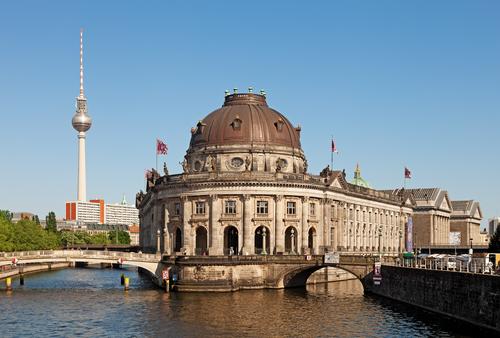 Museum Island BerlinPhoto:Thomas Wolf www.foto-tw.de CC 3.0 Unported no changes made
Museum Island BerlinPhoto:Thomas Wolf www.foto-tw.de CC 3.0 Unported no changes made
Visitors to Museum Island will mainly spend time at the Alte Nationalgalerie, which features exhibitions of German paintings and sculptures, as well as a number of important works of art by the French Impressionists and 24 paintings by Caspar David Friedrich. The Altes Museum is a striking building designed by Karl Friedrich Schinkel. On the ground floor you can see an extensive collection of antiquities and on the top floor there are many changing exhibitions.
Tips
In addition to the sights of Berlin, you can also dine in the city. A nice side effect: eating out is incredibly cheap in many restaurants in Berlin. For the prices they charge in these eateries, you can hardly prepare a meal yourself. You can immediately tell from the restaurants in Berlin that the city is a real melting pot of cultures: you can really eat everything from typical German dishes to doner kebab. You read it already: there is plenty to do in Berlin.
Useful links Berlin
BBC Country ProfilesWorld Fact Book Explore all Countries
How to call
Last updated November 2025
Copyright: Team - The World of Info